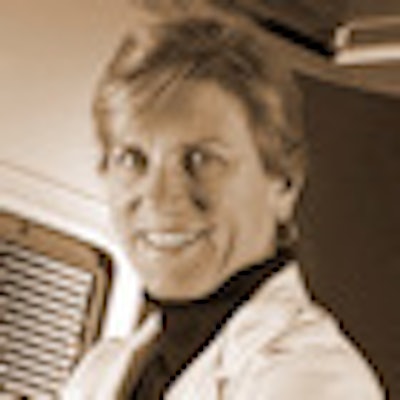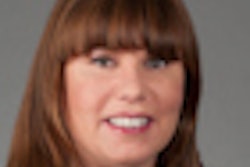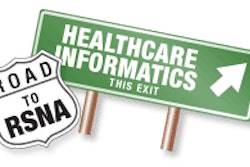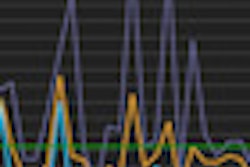
Where can radiation oncologists working in community hospitals get advice or feedback about a treatment plan for a patient? If they have an Internet connection, they can join Chartrounds, a virtual networking site that links radiation therapy luminaries with any practicing radiation oncologist in the world.
Chartrounds hosts virtual "rounds" that allow radiation oncologists to talk online about patient cases with academic experts and other radiation oncologists participating in the session. Several hour-long sessions, each focusing on a specific type of cancer, take place each week, providing a forum for predominantly community-hospital-based radiation oncologists to share their radiotherapy treatment plans for patients, solicit opinions from their peers, and ask advice from the academic expert who leads the session.
 Dr. Patricia Harrigan Hardenbergh.
Dr. Patricia Harrigan Hardenbergh.Participating in Chartrounds is free for any radiation oncologist or cancer treatment physician, thanks to a three-year $1.35 million grant from the American Society of Clinical Oncology (ASCO) Conquer Cancer Foundation, supported by Susan G. Komen for the Cure. While Chartrounds originally focused on the U.S., participation has grown international in scope to include radiation oncologists from 14 additional countries. The organization is now planning to expand its scope to other cancer-related specialists, including medical oncologists and radiologists.
Chartrounds is the brainchild of Dr. Patricia Harrigan Hardenbergh, medical director of radiation oncology at Shaw Regional Cancer Center in Edwards, a town of about 10,000 in the mountains of Colorado. Hardenbergh did her residency at Harvard Medical School in Boston and practiced as a breast radiation oncologist at Duke University Medical Center in Durham, NC. Until she was recruited to head the radiation oncology department of the new cancer treatment center in rural Colorado, she worked in an academic environment filled with specialists with whom she could easily confer.
The transition to the community center required Hardenbergh to treat all types of cancer, and it revealed how isolating this type of clinical work environment can be. The U.S. National Cancer Institute estimates that approximately 85% of cancer patients are treated in community healthcare facilities, many of which are solo practices or have just a few radiation oncologists. Hardenbergh benefited from a network of former colleagues she could contact for advice, but she realized that having convenient access to experts was a void in cancer care in the U.S.
"Community cancer centers are wonderful," Hardenbergh said."However, there is a gap in expertise between community and academic centers, and my goal was to find a way to bridge it."
So she applied for a grant to develop Chartrounds, and her application, along with one from Dana Farber Cancer Institute in Boston, received grants under ASCO's Improving Cancer Care Grants program in 2010.
"I thought this was quite a vote of confidence and recognition by the ASCO Conquer Cancer Foundation that we should look to see what the community thinks we should do to improve cancer care," she said.
How Chartrounds works
The project began in July 2010 with the development of the website and infrastructure, as well as the recruitment of academic experts to serve as faculty. Chartrounds launched its first session in December 2010. For the first 10 months, breast cancer treatment was the exclusive topic.
With the addition of sessions on head and neck, lung, and gynecologic cancers in September 2011, the number of registered radiation oncologists almost doubled. Today, sessions are now being offered on lymphoma; gastrointestinal, central nervous system, prostate, and skin cancers; pediatric cancer in general; and stereotactic body radiation therapy (SBRT). Twenty-six disease-site specialists now lead these programs.
Membership is targeted to all practicing radiation oncologists or medical oncologists. After completing an online application, the physician is thoroughly vetted. When members sign up for sessions, they are required to complete "submit case" forms that include patient demographic information; applicable medical history; treatment to date; chemotherapy regimen, if applicable; and planned radiation oncology treatment. Participants are encouraged to submit diagnostic images used in treatment planning as a PDF file or with a direct link to the member's treatment planning computer.
Attendees present their cases and their proposed treatment plans. Participants typically present cases to verify that the treatment plan they've developed reflects the best patient care. Discussion is strongly encouraged by all participants as well as by the specialist. "We have some robust conversations," Hardenbergh said.
What happens when the treatment plan presented is incorrect?
"This has happened," she said. "The session leaders are not only experts in their field, they are senior faculty at academic institutions. They take a diplomatic and kind approach. They may say, 'Well, at my hospital we typically would ...' and explain what should be done, or they may ask each of the other session participants what they would do before offering their own suggestion. The consensus opinions tend to reflect the appropriate treatment."
Participants in Chartrounds forums report that they make some change in treatment about 80% of the time. In a questionnaire participants are required to complete to receive CME credit, they are asked if a change will be made in radiation dose, fields, or clinical management, or if there is no change at all.
More than one-third of respondents have said they would change clinical management, 9% reported a change in radiation prescription dose, 17% reported a change in radiation fields, and 17% indicated a change in the selection of patients for radiation.
Expansion
As of late October, Chartrounds had more than 760 enrolled members from all 50 states and Puerto Rico and from 15 countries, Hardenbergh told attendees at a scientific session at this year's American Society for Radiation Oncology (ASTRO) annual meeting in Boston. In its initial 14 months of operation, 19 specialists have led 102 sessions. During this time, there was an average attendance ratio of six community physicians to one specialist; in 2012 this ratio increased to 11:1.
Chartrounds is steadily expanding, and although there are language and time zone barriers, Hardenbergh is encouraged by the internationalization of Chartrounds. Archived sessions will soon be accessible to members on its website. Tumor board sessions and sessions targeted specifically to medical oncologists and radiologists are planned.
How effective is the site? Very effective, if the CME questionnaires are any indication. Using a five-point scale, with 5 representing the greatest effect possible, the 102 sessions received a mean survey response of 4.5 for relevancy to daily practice and 4.2 regarding impact on treatment plan.
"I think that Chartrounds is making an impact on the quality of care of radiation oncology practices in community cancer centers," Hardenbergh said. "Our future directions of this project are aimed at demonstrating how these changes could result in significant improvements in cancer care."
Applications to join Chartrounds can be accessed here.



















